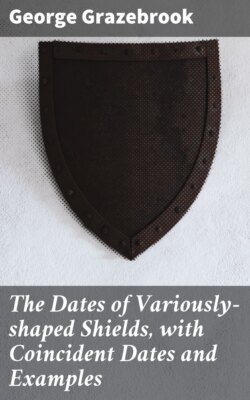Читать книгу The Dates of Variously-shaped Shields, with Coincident Dates and Examples - Grazebrook George - Страница 8
На сайте Литреса книга снята с продажи.
THIRTEENTH CENTURY.
ОглавлениеTable of Contents
In the earliest years of this century Norman shields curved round the body still continue; while in seals, which at this date are our principal source of evidence, animals, such as dragons, appear to fill up the field, and especially to support a plain shield in large counterseals; also distinctive badges are introduced, such as cinquefoils, estoiles, mascles, boars' heads, lions, &c.; but sometimes in character they follow greatly the pattern obtaining at the end of the twelfth century. "Heater-pear" No. 6 occurs, and frequently such a shield stands in the centre of a circular seal, merely surrounded by the inscription in longobardic. The heater shield is now rather more pointed than it appears in later examples.
A very curious triangular shield No. 1 also now appears, as in the seal of Johannes fil. Galfridi de Edinton, such a triangular shield on a plain circular field, around which is the inscription, in plain Roman capitals. This is engraved in the Visit. Hunts., 1613, p. 100. Another seal, Nigellus de Amundeville, is entirely three-cornered, a little longer than an equilateral triangle; the shield is of the same contour, and shows three chevrons, while the edging leaves space for the inscription round the three sides. This is also engraved in the Visit. of Huntingdon, 1613, p. 121, published by the Camden Society. This shape of triangular seal seems to have been more common than was supposed. The curious seal of the Treverbin family of Cornwall is engraved, Archæological Journal, vol. x, p. 150; but, as it shows no shield, it stands outside our present subject.
Another curious shield is figured in Nicholas Upton, De Usu Militari, Bisse edition, 1654, p. 37, and of date 1257 (see No. 47). Henry de Fernbureg stands with a square shield in his left hand. It is about two feet long, considerably curved, and appears to be very thick. In his right hand he holds a hammer extending into a sharp spike at the back. Square shields very much like this, but more oblong in shape, and with a round boss projecting from the middle, occur in the very curious illustration of a wager of duel in the Miscel. Rolls, temp. Henry III., and therefore of date 1210–50. Each duellist carries such a shield; they must be over two feet long, and are much curved; while with the other hand he wields an awkward looking hammer, or more properly a pick, as it is pointed at both ends; while, after the manner of ancient pictures, the vanquished (and therefore the guilty one) is seen hanging up in the background. This is engraved in Hewitt's Ancient Armour, vol. i, p. 375, also in Madox's History of the Exchequer, p. 383.
In the very curious instance of the seal of Thomas Furnival, his arms are shown in a lozenge-shaped shield. This is of date 1274–9, and is engraved in Herald and Genealogist, vol. iii, p. 334. Even at this early date such a shape seems to have been usually reserved for ladies. Sir George Mackenzie [quoted in Guillim's Display, ed. 1724] mentions that Muriell, Countess of Stratherne, bore her arms in a lozenge in 1284.
Another very curious shield of Helie Count de Maine is reproduced in Montfauçon's Monarchie Française. This is a wedge-shaped or triangular shield, but the top has square corners and is peaked (see No. 48). The seal of Turstan Dispensator Regis, about 1210, shows the heater-pear with the upper corners slightly varied. This is engraved in Collect. Top. et Gen., vol. iv, p. 239. The ancient arms of Despencer are said to have been Ermine, a chief Gules; but this seems to represent … six cloves, four and two, and a chief; and to fill up the space three cinquefoils are introduced in the field.
But, as before laid down, the general shapes of shields in this century are the Norman No. 2, often of very long proportions, as shown in William de Longespee, Earl of Sarum, 1226, and the statues at Wells Cathedral, 1230; the heater-pear No. 6, and the plain heater No. 5, rather long and pointed. A Clifford seal given in Nicholas Upton, p. 91, of date 1220, has a heater-pear shield on the seal, and an ordinary heater on the smaller counterseal (see No. 49). We may remark that on the tomb of Queen Eleanor, in Westminster Abbey, appears, on a long-shaped heater shield, the first example of quartering in England which just comes within the limits of the thirteenth century. This represents the two kingdoms of Castile and Leon, but it was undoubtedly the example which afterwards led to regular quarterings of arms by families.
It is noticeable that during the latter half of this century shields begin to be shown in seals, suspended by the guige, which is passed round a tree or other device from which it can hang.
Flowers, leaves, and even architectural details, enarching, &c., now begin to appear, to fill up the field, and the whole tone approaches the style prevailing in the following century.
It may be as well to remark in this place that milled, dotted, or roped lines around seals are no indication of date. They appear in all these varieties as early as William the Conqueror, and extend to the latest times, according to the fancy of the artist.
Inscriptions are in longobardic, with plain Latin capitals often alternated; and in the seal of Henry II. the letter R has a line across the tail, signifying a contraction—HENR for Henrici.
Until the end of this century a cross is used at the beginning of the inscriptions, but about 1275 stars appear, and in the next century trefoils and other devices are frequently introduced instead of crosses.
